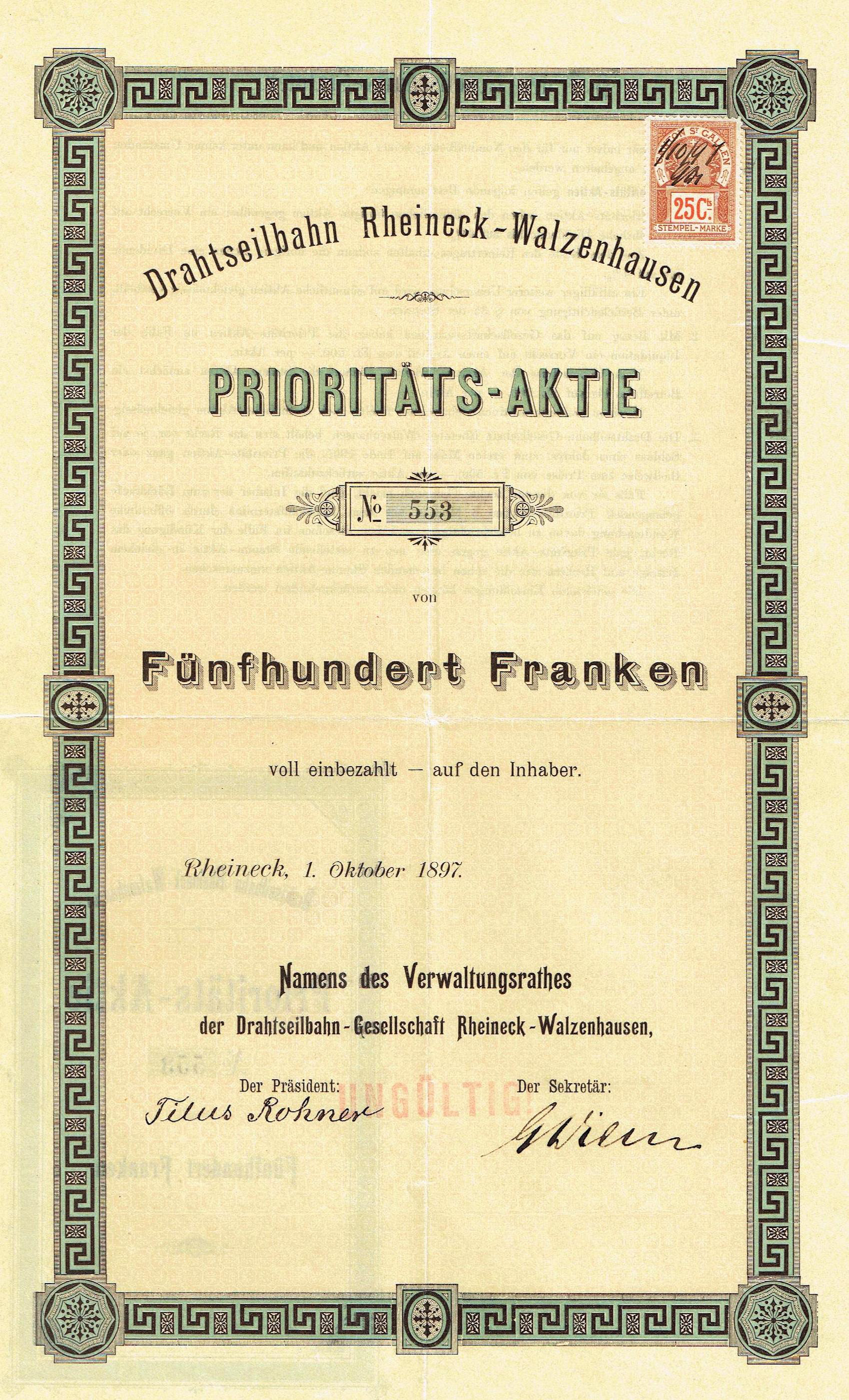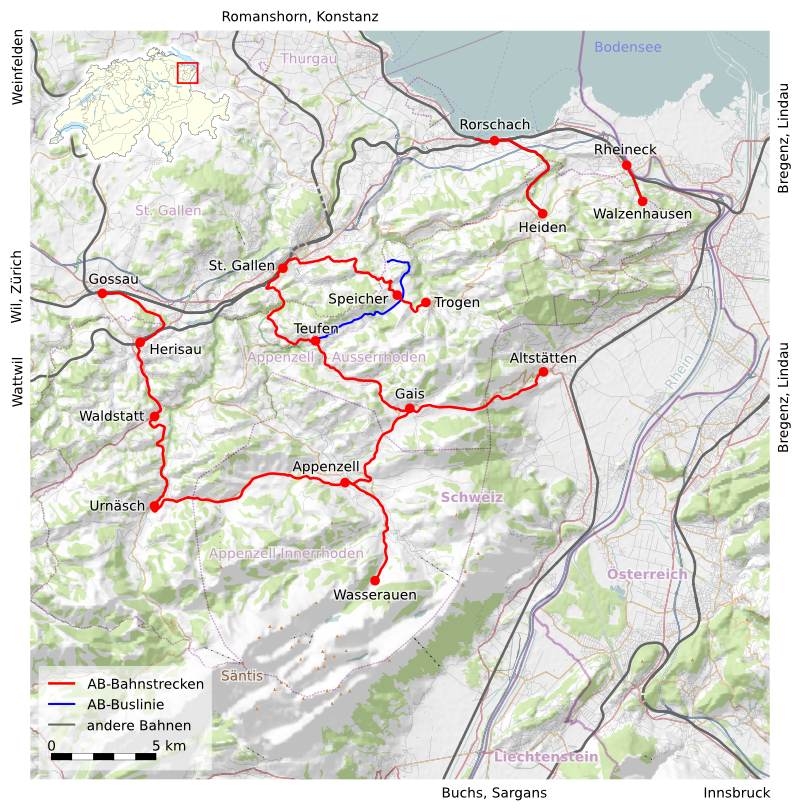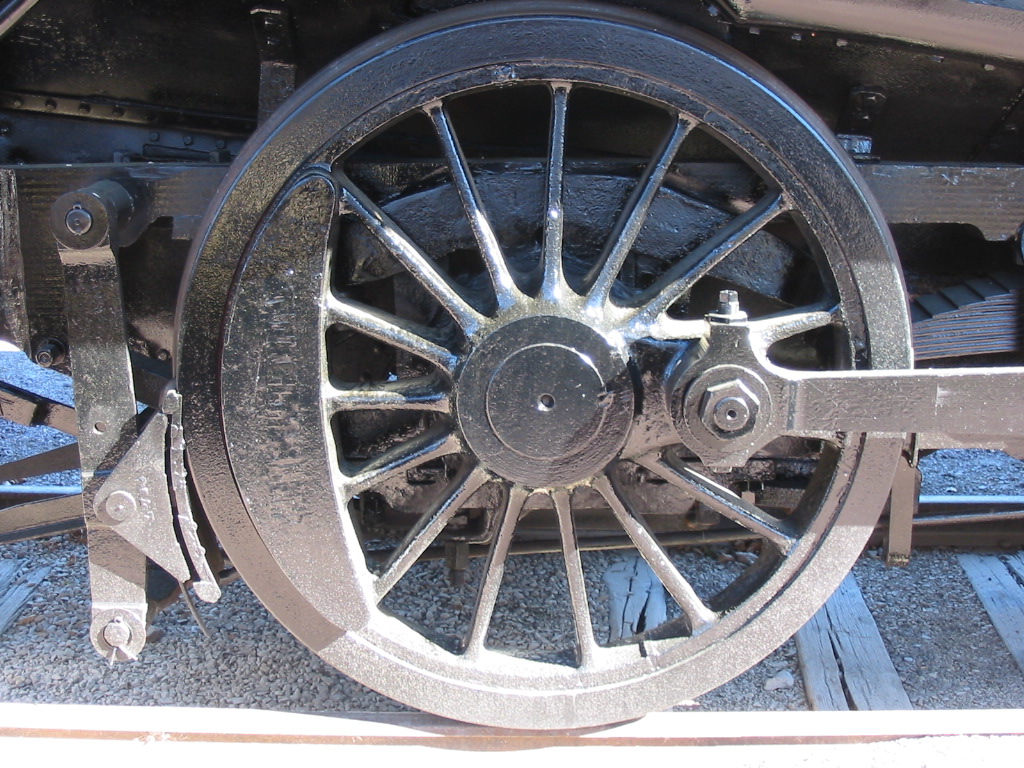|
Rheineck–Walzenhausen Mountain Railway
The Rheineck–Walzenhausen mountain railway (german: Bergbahn Rheineck–Walzenhausen; RhW) is a long rack railway in Switzerland. It links Rheineck station, in the municipality of Rheineck and the canton of St Gallen, with the village and health resort of Walzenhausen, in the canton of Appenzell Ausserrhoden. Passenger service on the line now forms part of the St. Gallen S-Bahn, branded as the S26. The line is owned and operated by the Appenzell Railways company, which also operates several other railway lines in the two Appenzell cantons. History The concession for the construction of a rail link between Rheineck and Walzenhausen was granted in 1889. The ''Drahtseilbahn-Gesellschaft Rheineck-Walzenhausen'' company started construction in 1895 and the line opened on 27 June 1896. As constructed, the line was a water operated funicular railway that linked the current upper station at Walzenhausen with a lower station at Ruderbach, some short of Rheineck station. In 1909, a ... [...More Info...] [...Related Items...] OR: [Wikipedia] [Google] [Baidu] |
Appenzell Railways
Appenzell Railways (german: Appenzeller Bahnen, AB) is a Swiss railway company with headquarters in Herisau. It operates a network of railways in the cantons of Appenzell Innerrhoden, Appenzell Ausserrhoden, St. Gallen and Thurgau. History The origins of the Appenzeller Bahnen company lies in a number of formerly independent companies and railway lines: * The Rorschach–Heiden-Bergbahn (RHB), which opened its line from Rorschach to Heiden in 1875. * The Appenzellerbahn (AB), which opened its line from Winkeln to Urnäsch via Herisau in 1875, with an extension from Urnäsch to Appenzell in 1886. In 1913, the line from Herisau to Winkeln was replaced by a new line to Gossau. * The Frauenfeld–Wil railway (FW) in 1887 * The St. Gallen–Gais–Appenzell-Bahn (SGA), which opened between St. Gallen and Gais in 1889, and was extended to Appenzell in 1904. * The Rheineck–Walzenhausen-Bergbahn (RhW), which opened between Rheineck and Walzenhausen in 1896. * The Trogenerb ... [...More Info...] [...Related Items...] OR: [Wikipedia] [Google] [Baidu] |
Tram
A tram (called a streetcar or trolley in North America) is a rail vehicle that travels on tramway tracks on public urban streets; some include segments on segregated right-of-way. The tramlines or networks operated as public transport are called tramways or simply trams/streetcars. Many recently built tramways use the contemporary term light rail. The vehicles are called streetcars or trolleys (not to be confused with trolleybus) in North America and trams or tramcars elsewhere. The first two terms are often used interchangeably in the United States, with ''trolley'' being the preferred term in the eastern US and ''streetcar'' in the western US. ''Streetcar'' or ''tramway'' are preferred in Canada. In parts of the United States, internally powered buses made to resemble a streetcar are often referred to as "trolleys". To avoid further confusion with trolley buses, the American Public Transportation Association (APTA) refers to them as "trolley-replica buses". In the Unit ... [...More Info...] [...Related Items...] OR: [Wikipedia] [Google] [Baidu] |
Rorschach, Switzerland
Rorschach () is a municipality, in the District of Rorschach in the canton of St. Gallen in Switzerland. It is on the south side of Lake Constance (''Bodensee''). History Rorschach is first mentioned in 850 as ''Rorscachun''. In 947, Otto I granted the abbot of St. Gall the right to operate markets, mint coins and levy tariffs at Rorschach. In 1489-90 the Rorschacher Klosterbruch or destruction of the abbey at Rorschach touched off the St. Gallen War. Following decades of conflict with the city of St. Gallen, in late 1480 Abbot Ulrich Rösch began planning to move the abbey away from the city of St. Gallen to Rorschach. By moving he hoped to escape the independence and conflict in the city. Additionally, by moving closer to the important lake trade routes, he could make Rorschach into a major harbor and collect a fortune in taxes. In turn Mayor Varnbüler and the city feared that a new harbor on the lake would cause trade to bypass St. Gallen and Appenzell. They would then ... [...More Info...] [...Related Items...] OR: [Wikipedia] [Google] [Baidu] |
Heiden, Switzerland
Heiden is a village and a municipality in the canton of Appenzell Ausserrhoden in Switzerland. Its Biedermeier village around the church square is listed as a heritage site of national significance. History Heiden is first mentioned in 1461 as ''guot genant Haiden''. Heiden, Lutzenberg, and Wolfhalden originally were parts of a single municipality named the Kurzenberg. Around 1650, Heiden and Wolfhalden could not agree about control over the local church. This led to the creation of a separate church in each village in 1652, making them independent. In 1658 the Kurzenberg was split into the three separate municipalities in defiance of the canton government. Their borders were officially established in 1666-67. The founder of the Red Cross, Henry Dunant, spent his last years in Heiden. The former president of the ICRC, Jakob Kellenberger, was also born in Heiden. Geography Heiden has an area, , of . Of this area, 52.4% is used for agricultural purposes, while 30.6% is f ... [...More Info...] [...Related Items...] OR: [Wikipedia] [Google] [Baidu] |
Rorschach–Heiden Railway
The Rorschach–Heiden railway (german: Rorschach-Heiden-Bahn, RHB) is a railway line and former railway company in Switzerland. It is a standard gauge Mountain railway, mountain rack railway, using the Riggenbach rack system and is part of Appenzeller Bahnen. The route links Rorschach, St. Gallen, Rorschach with Heiden, Switzerland, Heiden. The line is popular with tourists for its scenic views over Lake Constance. During the summer months, it is operated with old open coaches. bodensee.eu Route The separate RHB line starts a half a kilometre east of Rorschach station, shortly after it branches off from the Rorschach – Chur line belonging to the Swiss Federal Railways (SBB). The property line is exactly at kilometre 64.41483. The ...[...More Info...] [...Related Items...] OR: [Wikipedia] [Google] [Baidu] |
Railroad Switch
A railroad switch (), turnout, or ''set ofpoints () is a mechanical installation enabling railway trains to be guided from one track to another, such as at a railway junction or where a spur or siding branches off. The most common type of switch consists of a pair of linked tapering rails, known as ''points'' (''switch rails'' or ''point blades''), lying between the diverging outer rails (the ''stock rails''). These points can be moved laterally into one of two positions to direct a train coming from the point blades toward the straight path or the diverging path. A train moving from the narrow end toward the point blades (i.e. it will be directed to one of the two paths, depending on the position of the points) is said to be executing a ''facing-point movement''. For many types of switch, a train coming from either of the converging directions will pass through the switch regardless of the position of the points, as the vehicle's wheels will force the points to move. ... [...More Info...] [...Related Items...] OR: [Wikipedia] [Google] [Baidu] |
Level Crossing
A level crossing is an intersection where a railway line crosses a road, Trail, path, or (in rare situations) airport runway, at the same level, as opposed to the railway line crossing over or under using an Overpass#Railway, overpass or tunnel. The term also applies when a light rail line with separate Right-of-way (railroad), right-of-way or reserved track crosses a road in the same fashion. Other names include railway level crossing, railway crossing (chiefly international), grade crossing or railroad crossing (chiefly American), road through railroad, criss-cross, train crossing, and RXR (abbreviated). There are more than 100,000 level crossings in Europe and more than 200,000 in North America. History The history of level crossings depends on the location, but often early level crossings had a Flagman (rail), flagman in a nearby booth who would, on the approach of a train, wave a red flag or lantern to stop all traffic and clear the tracks. Gated crossings bec ... [...More Info...] [...Related Items...] OR: [Wikipedia] [Google] [Baidu] |
Swiss Federal Railway
Swiss Federal Railways (german: link=no, Schweizerische Bundesbahnen, ''SBB''; french: link=no, Chemins de fer fédéraux suisses, ''CFF''; it, Ferrovie federali svizzere, ''FFS'') is the national railway company of Switzerland. It is usually referred to by the initials of its German, French, and Italian names, either as SBB CFF FFS, or used separately. The Romansh version of its name, ''Viafiers federalas svizras'', is not officially used. The official English abbreviation is "SBB", instead of the English acronym such as "SFR", which stands for ''Swiss Federal Railways'' itself. The company, founded in 1902, is headquartered in Bern. It used to be a government institution, but since 1999 it has been a special stock corporation whose shares are held by the Swiss Confederation and the Swiss cantons. It is currently the largest rail and transport company of Switzerland, and operates on most standard gauge lines of the Swiss network. It also heavily collaborates with ... [...More Info...] [...Related Items...] OR: [Wikipedia] [Google] [Baidu] |
Grade (slope)
The grade (also called slope, incline, gradient, mainfall, pitch or rise) of a physical feature, landform or constructed line refers to the tangent of the angle of that surface to the horizontal. It is a special case of the slope, where zero indicates horizontality. A larger number indicates higher or steeper degree of "tilt". Often slope is calculated as a ratio of "rise" to "run", or as a fraction ("rise over run") in which ''run'' is the horizontal distance (not the distance along the slope) and ''rise'' is the vertical distance. Slopes of existing physical features such as canyons and hillsides, stream and river banks and beds are often described as grades, but typically grades are used for human-made surfaces such as roads, landscape grading, roof pitches, railroads, aqueducts, and pedestrian or bicycle routes. The grade may refer to the longitudinal slope or the perpendicular cross slope. Nomenclature There are several ways to express slope: # as an ''angle'' of inc ... [...More Info...] [...Related Items...] OR: [Wikipedia] [Google] [Baidu] |
Rail Adhesion
An adhesion railway relies on adhesion traction to move the train. Adhesion traction is the friction between the drive wheels and the steel rail. The term "adhesion railway" is used only when it is necessary to distinguish adhesion railways from railways moved by other means, such as by a stationary engine pulling on a cable attached to the cars or by railways that are moved by a pinion meshing with a rack. The friction between the wheels and rails occurs in the wheel-rail interface or contact patch. The traction force, the braking forces and the centering forces, all contribute to stable running. However, running friction increases costs by requiring higher fuel consumption and by increasing the maintenance needed to address fatigue (material) damage, wear on rail heads and on the wheel rims and rail movement from traction and braking forces. Variation of friction coefficient Traction or friction is reduced when the top of the rail is wet or frosty or contaminated with grea ... [...More Info...] [...Related Items...] OR: [Wikipedia] [Google] [Baidu] |
Overhead Line
An overhead line or overhead wire is an electrical cable that is used to transmit electrical energy to electric locomotives, trolleybuses or trams. It is known variously as: * Overhead catenary * Overhead contact system (OCS) * Overhead equipment (OHE) * Overhead line equipment (OLE or OHLE) * Overhead lines (OHL) * Overhead wiring (OHW) * Traction wire * Trolley wire This article follows the International Union of Railways in using the generic term ''overhead line''. An overhead line consists of one or more wires (or rails, particularly in tunnels) situated over rail tracks, raised to a high electrical potential by connection to feeder stations at regular intervals. The feeder stations are usually fed from a high-voltage electrical grid. Overview Electric trains that collect their current from overhead lines use a device such as a pantograph, bow collector or trolley pole. It presses against the underside of the lowest overhead wire, the contact wire. Current collectors ar ... [...More Info...] [...Related Items...] OR: [Wikipedia] [Google] [Baidu] |
S-Bahn St
The S-Bahn is the name of hybrid urban- suburban rail systems serving a metropolitan region in German-speaking countries. Some of the larger S-Bahn systems provide service similar to rapid transit systems, while smaller ones often resemble commuter or even regional rail. The term derives from ''Schnellbahn'', ''Stadtbahn'' or ''Stadtschnellbahn''. Similar systems in Switzerland are known as S-Bahn as well. In Belgium it is known as S-Trein (Flemish) or Train S (French). In Belgium there are S-Trains in the five largest cities: Brussels, Antwerp, Liège, Ghent and Charleroi. In Denmark, they are known as S-tog , in the Czech Republic as Esko or S-lines. Characteristics There is no complete definition of an S-Bahn system. S-Bahn are, where they exist, the most local type of railway stopping at all existing stations inside and around a city, while other mainline trains only call at major stations. They are slower than mainline railways but usually serve as fast crosstown se ... [...More Info...] [...Related Items...] OR: [Wikipedia] [Google] [Baidu] |










.jpg)